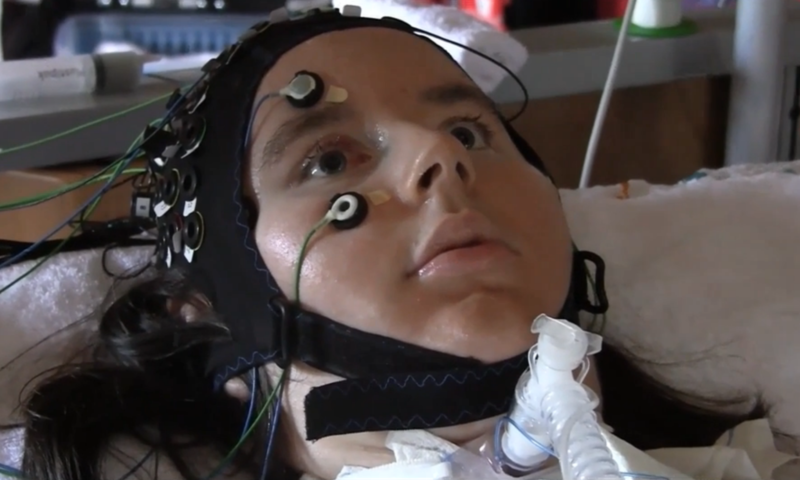Neurointerface tells how fully paralyzed patients feel

The patient answers the questions of researchers.
The most difficult case of paralysis is the variant with the complete absence of any motor-motor activity. That is, a person is conscious, but he cannot move his hand or finger, to blink or look to the side. The condition of such patients is difficult to envy - after all, a person cannot ask others to show a favorite movie, flick through a favorite book or do something else.
Technologies are moving forward, and now they help to establish communication with such patients. The new neurointerface, which is based on measuring brain activity and blood flow, allows you to establish a communication channel with “closed in yourself” patients. This conclusion was made by a group of scientists after working with four fully paralyzed patients. Their paralysis is caused by a disease such as amyotrophic lateral sclerosis (Stephen Hawking suffers from it). Scientists managed to get answers to questions on geography, get the right answers to a question about family members and others.
The study is led by Niels Birbaumer, an employee of the Wyss Center for Bio and Neuroengineering, an organization based in Geneva. According to him , the reaction of paralyzed patients caused a violent reaction of their families.
')
Lateral (lateral) amyotrophic sclerosis (ALS) (also known as motor neuron disease, Motoneuronal disease, Charcot's disease, in English-speaking countries, Lou Gehrig's disease) is a slowly progressive, incurable degenerative disease of the central nervous system in which damage occurs to both the upper (motor cortex) and lower (front horns of the spinal cord and cranial nerve nuclei) of motor neurons, which leads to paralysis and subsequent muscle atrophy.
This disease is characterized by a progressive lesion of the motor neurons, which are accompanied by paralysis of the limbs and muscle atrophy. In this case, death comes from respiratory tract infections or respiratory muscles. Unfortunately, the cause of ALS is unknown. In 5% these are hereditary forms of the disease, in 20% of these are mutations of the superoxide dismutase-1 gene located on the 21st chromosome. It is believed that the progress of the disease is caused by increased activity of the glutamatergic system. In this case, an excess of glutamic acid causes overexcitation and death of neurons. Muscle twitching in this case corresponds to the death of one of the motor neurons in the spinal cord. That is, the muscle site is deprived of innervation and is no longer able to contract normally.

Initially, the neural interface was tested on healthy people.
So, the doctors tried to find a way to communicate with completely paralyzed people who were conscious for many years. In 1999, Birbaumer and his colleagues discovered a way to communicate with patients who still have the ability to move eyeballs. Over time, outside researchers have developed methods for interacting with paralyzed people by analyzing blood flow and brain electrical activity. But these methods, however, were useless with respect to fully paralyzed patients.
Now the situation has changed. Doctors have created a special neural interface, which consists of a grid of electrodes that are worn on the human head. With the help of near-infrared spectroscopy and electroencephalography, scientists have learned to measure in real time the level of oxygen in the blood and the electrical activity of the brain. When creating such a system, the main task was to interpret the reaction of the patient's body, that is, it was necessary to understand when a person says “yes” and when “no”. The researchers used questions like "Is Paris the capital of Germany?" And "Is your husband Yohim?" To train the subject and test the interface.
Analysis of the response of patients showed a coincidence of the body's response to 70%. That is, the repetition of the same question caused the coincidence of the response by 70%. After the neural interface was tested, more complex questions followed, such as “Does your back hurt?”, “Do you want to live?” And “Do you rarely be sad?”.
After careful interpretation of the results, the scientists decided to ask how happy these people are (recall that they are in a completely paralyzed state for several years). Of the four people, three said they were satisfied with life and wanted to live on. These questions were not asked to the fourth patient at the request of the parents, who were afraid to harm their daughter.
One of the patients was also asked if he gave the blessing of his daughter to the wedding with her young man. The man gave a negative answer.
The researchers argue that the survey results need further verification, and the neurointerface itself needs to be tested and improved. Nevertheless, scientists believe that the technology will help to establish communication with fully paralyzed patients, which will improve their quality of life and strengthen their socialization.
DOI: 10.1371 / journal.pbio.1002593
Source: https://habr.com/ru/post/401281/
All Articles